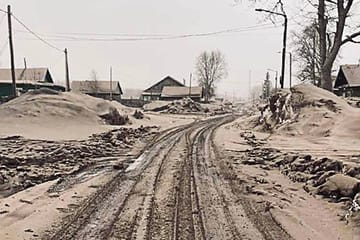The cloud of smoke above the Schiwelutsch is said to be more than 20 kilometers high. Does the eruption of the volcano in eastern Russia have unexpected effects?
Since 1999, the Schiwelutsch has shown again and again what enormous powers lie dormant in it. In 2005, the volcano on the Kamchatka peninsula sent a stream of hot ash and gas 20 kilometers down the valley, and the volcanic dome then grew by half its size to more than 3,000 meters. Since 2009, there have been columns of smoke up to 12 kilometers high over Mount Fire in Russia’s Far East. But the current outbreak could have far greater consequences.
“The continued activity could affect international and low-flying aircraft,” warned the Russian volcano observatory KVERT on Tuesday morning. The ash cloud is said to have reached a height of 20 kilometers. The highest red alert level has been declared for air traffic. The ash rain continues and is already the largest in the past 60 years, according to the authorities. In the village of Klyuchi, 47 kilometers from the volcano, almost three inches of ash fell in four hours.
Embed
Problems for air traffic between Japan and the USA?
As the newspaper “Kommersant” reports, the people in Klyuchi are now supplied with drinking water from the naval base in Petropavlovsk-Kamchatsky, 450 kilometers away. Only a viscous gray mud should come out of their taps. The volcanologists fear that the regional capital with its 180,000 inhabitants could also be hit by the ash cloud. The peninsula’s international airport, which is also used by the Russian army, is located in nearby Jelisovo. So far, however, the Kremlin has not commented on the possible impact on the Russian Pacific Fleet.
In any case, travelers between Japan and the USA should have problems – because the main flight route between the two countries runs along the peninsula. According to the Russian climate researcher Alexej Kokorin, the eruption of the Shiweluch could even trigger a short-term cooling of the earth’s atmosphere in the next two years due to the emitted particles.
Kamchatka has 29 active volcanoes
In this regard, the Schiweluch could also eclipse the 2010 Eyjafjallajökull eruption in Iceland. At that time, air traffic over Europe was paralyzed for weeks: “Everything was terribly seething, the planes didn’t fly, but there was no drifting into the stratosphere and therefore practically no impact on the climate,” Alexei Kokorin told the Ria Novosti news agency.
With an age between 60,000 and 70,000 years, the Schiwelutsch is one of the rather young volcanoes, writes the volcano expert and filmmaker Marc Szeglat on his website. The volcano experienced the most violent eruptions in its history between 6,500 BC and 650 AD. “The most severe eruptions in recent times occurred in 1854, 1956 and 1964 when large parts of the lava dome collapsed,” says Szeglat.
With 29 active volcanoes, Kamchatka is the region with the highest density of fire mountains in the world. The peninsula forms the northwestern part of the infamous Pacific Ring of Fire. Violent earthquakes and volcanic eruptions occur again and again along this ring. Kamchatka has been a UNESCO World Heritage Site since 1996.


